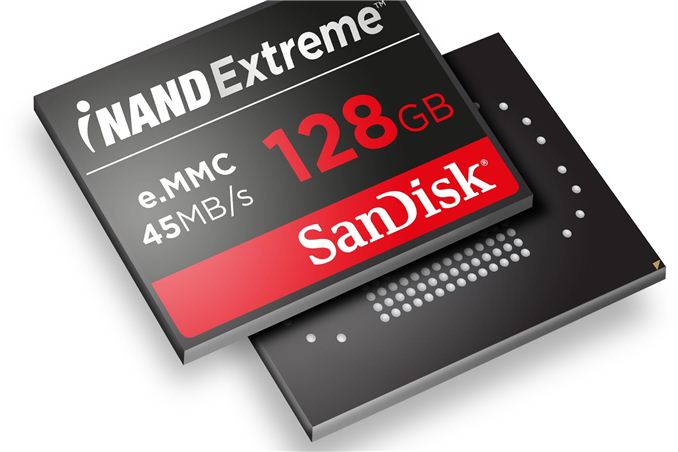SanDisk Announces Optimized iNAND Extreme eMMC for Bay Trail
by Anand Lal Shimpi on September 19, 2013 9:33 AM EST
We've started looking more closely at the embedded storage used in smartphones and tablets, and have mostly come away disappointed. Thankfully there appears to be some progress being made in the space. I remember being relatively impressed with the behavior of the eMMC in Intel's Bay Trail FFRDs at their benchmarking event a week and a half ago. The IO performance wasn't perfect, but it was definitely much better than I had been expecting.
Today SanDisk announced that it will be bringing an optimized version of its iNAND Extreme solution to Bay Trail tablets. Architecturally iNAND Extreme is a combination of NAND and eMMC controller in a single package. The device supports eMMC 4.51 (HS200) and uses SanDisk's own 19nm MLC (2bpc) NAND. Capacities go all the way up to 128GB for a single device, which SanDisk arrives at by stacking 16 x 64Gbit 19nm MLC NAND die.
Sustained performance isn't too shabby. SanDisk promises sequential reads/writes of up to 150/45MBps and 4KB random read/write speeds of up to 4K/800 IOPS. I suspect these numbers are based on the largest configurations, but I would expect similarly good performance even for the 64GB and maybe even 32GB versions. The 4KB random write results are sustained, not peak, and are measured by looking at performance across a 1GB LBA range. In the case of the 128GB drive that test leaves a ton of spare area, which helps explain the relatively good performance compared to what we're used to in the market. I'd love to see true worst case scenario performance for SanDisk's iNAND. The promised sequential read performance is outstanding. We've seen mobile devices break the 100MB/s sequential read barrier, but none have hit 150MB/s yet. Sequential write performance is also pretty good.
The Bay Trail optimizations come via some custom tuning on the firmware. I suspect Intel has its own performance targets and behaviors it wants to encourage on Bay Trail tablets and SanDisk is likely just responding to those requests. You can also find iNAND Extreme on other, non-Intel platforms as well.










13 Comments
View All Comments
k2_8191 - Thursday, September 19, 2013 - link
Finally light of performance improvement is shed on eMMC, right? (mm, bad pun)I hope smartphones and tablets won't be bothered by slower-than-USB2.0-memorysticks eMMCs in near future. My smartphone's storage is almost 5MB/s or less even in sequential reads...
Black Obsidian - Thursday, September 19, 2013 - link
Yes, it would be nice to have everything but the most budget devices be able to turn out decent storage performance.Equally nice would be if certain manufacturers (Apple foremost among them) stopped charging $100 for an extra $10 of flash.
thesavvymage - Friday, September 20, 2013 - link
why should they? The market has proven time and time again that they are willing to pay that amount. If there was a manufacturer that thought they could make more money by giving you more memory per dollar, they wouldImpulses - Thursday, September 19, 2013 - link
Would be nice if some of those devices also had USB 3.0 ports, otherwise those higher sequential speeds are of more limited use... Though I'm not sure how consumers and the market would react to the larger micro port (kind of a step back ergonomically, although I guess they can always fall back on USB 2.0 for charging). Is there an OTG spec for USB 3.0?kyuu - Thursday, September 19, 2013 - link
Awesome. This should greatly improve the experience on Win8 tabs. Hopefully this stuff is getting into tablets right away.robl - Thursday, September 19, 2013 - link
Thanks for the update! Anand, what are your thoughts on eMMC vs. a real SSD using M2 or one of the newer small form factors? Is it pricing? Or the interface? (likely both) I'd pay an extra $20 to finally get SSD performance on my tablet. Everything on my old N7 crawls to a halt when it's downloading or updating applications. The music stutters or stops, the UI freezes on and off, response to power and volume buttons is really poor. It has quad cores, but my guess is that the storage gets swamped by the simple update process and everything else starves. It's a real poor user experience IMHO.nathanddrews - Thursday, September 19, 2013 - link
I think the problem is that "real" SSDs use too much power (in comparison).Impulses - Thursday, September 19, 2013 - link
Are you running it near it's storage capacity limit and did you run the most recent update?robl - Friday, September 20, 2013 - link
Yup, I have 1GB out of 8GB free, and the latest update for hopefully for auto-trim. Thanks for the good thoughts, probably time for an upgrade. I'm just not sure if it's the storage that needs radical improvement or the latest Android upgrades slowing down the CPU.DanNeely - Thursday, September 19, 2013 - link
In the short term, phone/tablet SoCs only offer eMMC controllers. Long term isn't just more power; but that going from a single eMMC chip to an SSD controller, ram for the controller, and 2 (minimum) flash chips would take up too much PCB space. eMMC is a one chip solution not just for cost/power reasons but also because there isn't space in a phone for anything more.